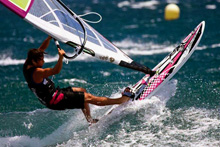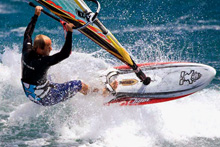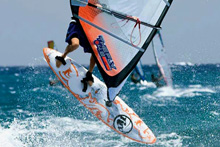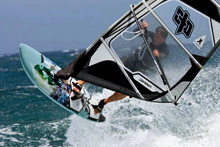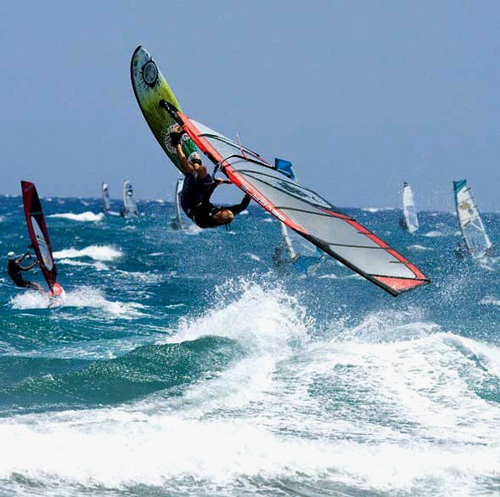
Dubbed “the missing link” by RRD, the Wave Thrusters are the first tri-fins to hit the scene from a mass-market manufacturer for a long time. We’re told that they’re fast and early planing boards that will feel as secure as a single-fin, but ‘turny’ and radical like a surfboard. RRD also state that they’ll be a pleasure for both onshore and cross shore sailing. There will be three sizes available – 68L, 76L and 84L – and these will be built in RRD’s custom-made full sandwich construction.
Design: With a maximum width of 58.5cm, the RRD is slightly wider than most of the twins on test, but it’s not the widest. It has a quoted volume of 84L, which is not unusual for its width, and it’s of a standard length at 230.5cm. The Wave Thruster has a fair amount of tail rocker for a waveboard of this size (9mm), and it has the longest planing flat of any of the boards featured in this test, with a 2cm point at 151.5cm. It has a tiny amount of vee in the tail, and a similarly small amount of double concave moving forwards. The board also features a very small swallowtail.
On the water: The first thing you notice about the RRD is that it performs well in chop compared to other boards in this test. You never get the feeling that you’re going to spin out, making it great for blasting out to sea in search of huge ramps to get airborne. It doesn’t have the super-loose feeling that some of the other boards have, and therefore requires a little bit more skill and effort to drive a really tight turn when going frontside in onshore conditions. It does however hold its speed well through the turn and really grips, so long as you keep to the same arc that you initiated. Through the top turn the board also grips well, making it easy to throw a fair amount of spray when you get it right. It wasn’t the quickest to plane, but did have a good top speed once up and going, and was great for backside riding in onshore mush.
Fittings: It comes with a 17.5cm MFC central fin with a US box fitting and a nice flex throughout, plus two 8cm, relatively swept-back and thick thruster fins with mini Tuttle box fittings. The straps are very comfortable, and although the pads are slightly thinner than we’re used to from RRD, they’re fine as well.
Overall: The Wave Thruster is at its best in onshore conditions when just riding backside, or in moderate to powered conditions and well-sized cross-shore waves for frontside riding. It doesn’t quite have the snappy turning ability of a twin-fin, but it does have heaps of grip, making it a winner when it comes to do-or-die bottom turns, or boosting backside aerials. If you like getting plenty of air on the way out, and you’re not too fussed about tight frontside turns in onshore conditions, then the RRD may well be the board for you.
Click here to read the BOARDS 256 Multi-Fin Waveboard test in full…

